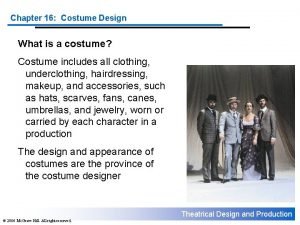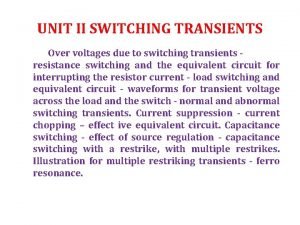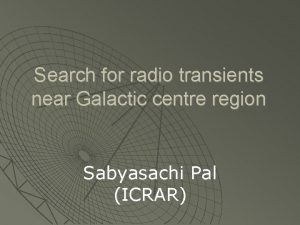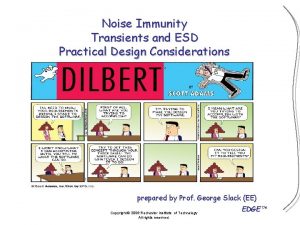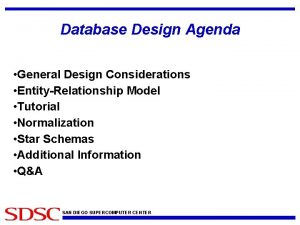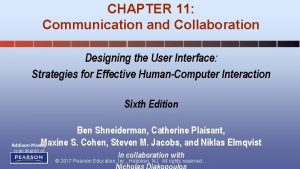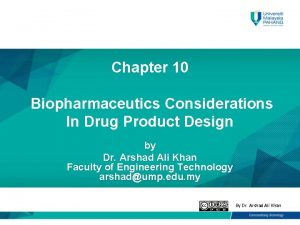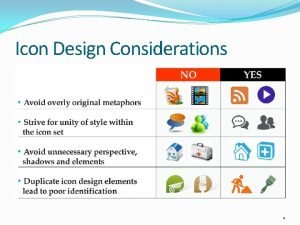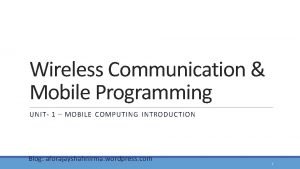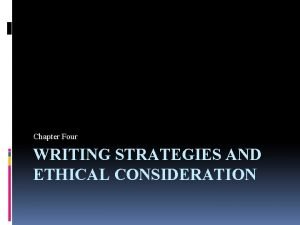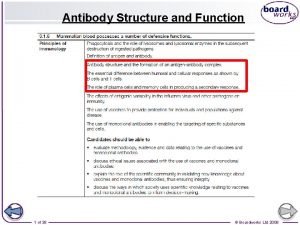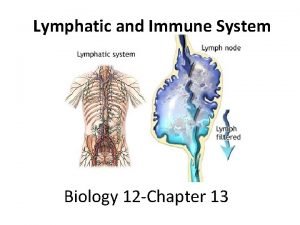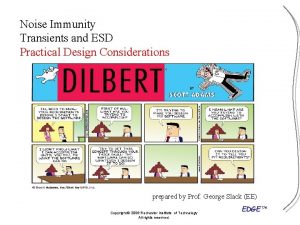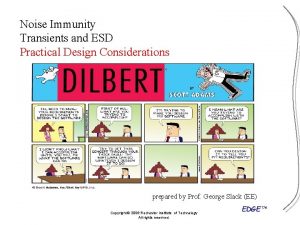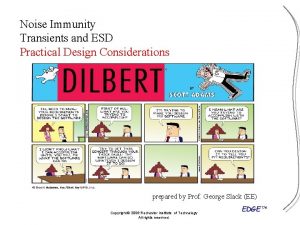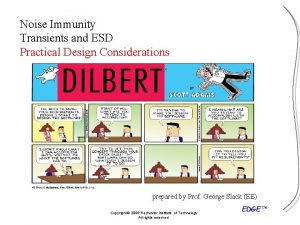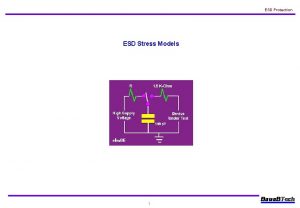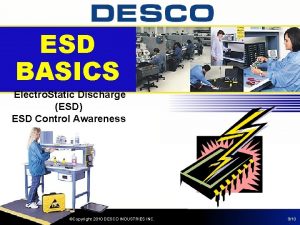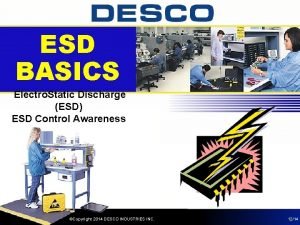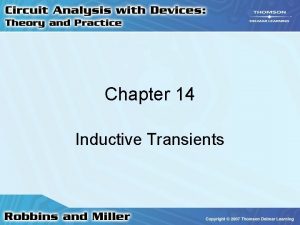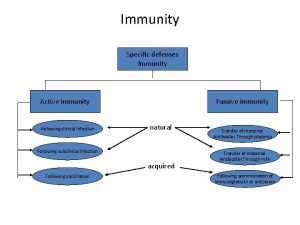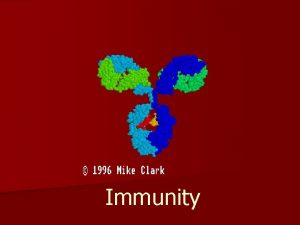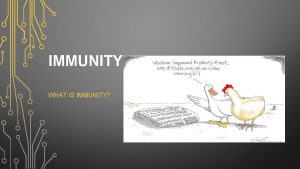Noise Immunity Transients and ESD Practical Design Considerations



















- Slides: 19

Noise Immunity Transients and ESD Practical Design Considerations prepared by Prof. George Slack (EE) Copyright © 2006 Rochester Institute of Technology All rights reserved. EDGE™

noise immunity • Circuit noise immunity is the ability of a device or component to operate in the presence of noise disturbance. • Electro Static Discharge is the sudden discharge (i. e. transients, surge). To the circuit, this is a rapid high voltage, low current situation. EDGE™

When is Noise Immunity design needed? • Senior Design I – Paper Design wks 1 -8 • Senior Design II – Prototype device testing wks 1 - 3. – Pre-integration testing with lab equipment DUT (device under test). Wks 3 - 6 EDGE™

Where does noise get into electronics? • 6. 4. 1 Sources * • • through ground connections and loops through power supply connections through signal inputs through inadvertent ESD – (human touch, lightning) • through Inductive devices (motors) • Electronic Instrumentation Design, Kim R. Fowler EDGE™

How does noise get into electronics? Energy Coupling (Conductive, Inductive, Capacitive) • EMI - Current surges (Electro. Magnetic Interference) An electrical disturbance in a system due to natural phenomena, low-frequency waves from electromechanical devices or high-frequency waves (RFI) from chips and other electronic devices. Allowable limits are governed by the FCC. RFI – high impedance devices requiring very limited current. (Radio Frequency Interference) High-frequency electromagnetic waves that emanate from electronic devices such as chips. If the source is sufficiently strong this can enter your circuit. EDGE™

ESD and unwanted signals • • • Fatal to Electronics: Inadvertent user misuse. Extreme cases of user abuse and solutions: – Bridge to block reverse polarity, – Schottky diode: very fast switching times and low forward voltage drop. As low as 0. 15 volts for low ma applications. – Zener diode across the input. – Circuit breaker – GFI EDGE™

Bare exposure to a CMOS gate Reduce Transients Protect from? • Misuse during debug and testing. • ESD and reverse polarity – Solution: Diode circuits to protect against • reduce transients – Component Specification Sheets – Solution: Low pass filter EDGE™

Polarity Protection (+) + Schottky diode 1 N 5822 or 1 N 5817 – (–) 1 N 4001 Input Port + Input Port – see 7. 4. 1 page 238, MOSFET solution EDGE™

Over-voltage Protection Fuse (+) (–) + input port – Zener diode 1 N 5339 (5. 6 V for a 5. 0 V input) EDGE™

Over-voltage Protection for Digital Inputs EDGE™

Minimize Bandwith One solution: Lowpass Filter EDGE™

Knowing Your Design Specification 1. If considering various output devices, review various manufactures specification sheets. 2. Current (i. e. CMOS versus TTL ). 3. Control Voltage (Vdd vary from 1. 5 VDC to 12 VDC typically) 4. Needed minimum Signal Transient Response. 5. RLC loads (dangerous current and voltage spikes) 6. Apply to Thevenin Equivalent Circuits – Source electronics – Device being driven EDGE™

Harness -Twisted Pair When purchasing harness cable: • Unshielded Twisted Pair (UTP) • Shielded Twisted Pair (STP) Study the manufacturer’s Specification to match to your needs. Practical Design Considerations http: //www. cirris. com/testing/twisted_pair/twist. html EDGE™

Harness Signal Response Design Considerations: data rate, distance, noise, parasitic capacitance, reflections. 1. Frequency Response/ Rise Time needs – DC to 100 khz Open Wire – DC to 40 MB/s Ribbon Cable (less than 3’) • • SCSI, SPI-3 applications http: //www. csee. umbc. edu/~plusquel/650/slides/ribbon_cables. pdf – DC to 300 mhz Twisted Pair - unshielded, ribbon – DC to 100/1000 MB/s 10/ 1000 Base. T ethernet Cat 5 minimum spec. RJ 45 connector. – Coax, VHF 3000 megahz (scope probe, cable TV) attenuation, reflectance, Cable TV, Rf • http: //www. netspec. com/helpdesk/wiredoc. html – DC to 4 gigahz Fiber Optics EDGE™

Harness -Twisted Pair What is does: Cancels out crosstalk from neighboring wires and electromagnetic interference from external sources EDGE™

CMOS characteristics Print out the specification sheets. • 1 u. A input? Not sure? Get the spec sheet!. . . • Draw the equivalent circuit for each internal pin. That is, CMOS versus TTL input impedance, output is pull-up or pull-down circuit, current limiting resistor value. • CMOS inputs have very high input impedance which is good for low power consumption for well protected electronics but susceptible to misuse when connecting to the outside world. EDGE™

Isolating Noise • Analog and Digital Optocoupler /Optoisolators Somewhat expensive ($1/ channel) but good isolation. – an electronic device that uses optics to transfer a signal while keeping the receiving and transmitting circuits electrically isolated • http: //www. analog. com (Analog Devices) • http: //www. optoinc. com/optocouplers 1. html • Power connection. • What does not work? – Fuses tipically are ineffective since a fuse is too slow to stop ESD current but good for harness shortcircuit. • Shielding • Fiber Optics – When higher speed data is needed. EDGE™

Isolators • Analog Devices, Isolators http: //www. analog. com/en/sub. Cat/0, 2879, 767%255 F 827%255 F 0%255 F, 00. html • Isolators: http: //www. analog. com/en/prod/0, 2877, ADu. M 2401, 00. html EDGE™

components and spec sheets http: //www. electronicstalk. com/guides/short-circuitprotection. html http: //www. maximic. com/appnotes. cfm/appnote_number/38 http: //www. onsemi. com/Power. Solutions/taxonomy. do? id=29 8 EMI RFI http: //www. edn. com/article/CA 326921. html http: //www. bussmann. com/library/techspec/Tech. Spec 19_su p. pdf#search=%22 short%20 circuit%20 protection%22 http: //www. elecdesign. com/Articles/Index. cfm? AD=1&Artic le. ID=5195 UL 489 and UL 1077 standards EDGE™
 Difference between acquired immunity and innate immunity
Difference between acquired immunity and innate immunity Practical considerations for costume design might include
Practical considerations for costume design might include Switching transients are *
Switching transients are * Galactic center radio transients
Galactic center radio transients Adaptive noise immunity
Adaptive noise immunity Companding quantization
Companding quantization Ethical consideration in experimental research sample
Ethical consideration in experimental research sample What are the general considerations in machine design
What are the general considerations in machine design Database design considerations
Database design considerations Collaboration design considerations
Collaboration design considerations Biopharmaceutic considerations in drug product design
Biopharmaceutic considerations in drug product design Final design icon
Final design icon Design considerations for mobile computing
Design considerations for mobile computing Writing strategies and ethical considerations
Writing strategies and ethical considerations Pricing considerations and approaches
Pricing considerations and approaches The difference between humoral and cell mediated immunity
The difference between humoral and cell mediated immunity Chapter 13 lymphatic system and immunity
Chapter 13 lymphatic system and immunity Immunity assignment slideshare
Immunity assignment slideshare Chapter 16 lymphatic system and immunity
Chapter 16 lymphatic system and immunity Main components of lymphatic system
Main components of lymphatic system

